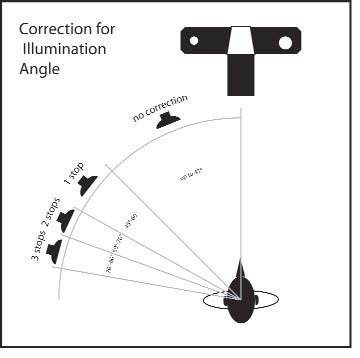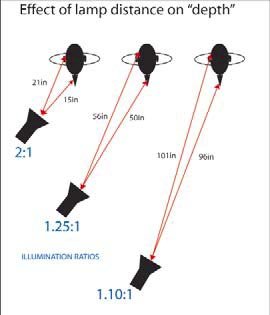articles/Portraiture/lowkeyportraiture-page2
Thoughts on low key portraiture - part 2 of 1 2 3 4 5 6 7
Published 01/06/2004

If you are looking for more sophistication, you can overlay numbers on your target and see if you can read them in your proposed viewing or display conditions. see image). As we illustrated in the feature on varnishes in paper Chase this issue, applying a varnish bring out shadow detail in a spectacular way and your tests should include the application of a varnish if that is what you propose to do. Expect to get at least another stop of tone at the dark end of the scale.
vNote: In general the use of the Look Up Tables (LUT) when printing on an Epson printer is less likely to block up your shadows. You get this when using the "Automatic" setting without bespoke colour profiles. It may work better for you so at least give it a try.
Setting up Your Lights
For some reason, today's textbooks tend to fight shy of writing about lighting and lighting ratios - typical of today's dumbing down! Make no mistake, a practical or practical and theoretical knowledge of lighting set ups can take you a long way. There are a number of fundamentals that you should understand about lights.

Inverse Square Law
The amount of light reaching a subject falls off as the subject is moved away form the light. If the distance is doubled, the light falls off by four times (i.e. 2 stops). This holds true for brollies, soft boxes and other diffused light sources. Very directional lighting such as that from the sun or a projector does not fall off. This is because the light rays are parallel to each other. For the case of the sun it is because it is so far away, for the projector it is because the lens optics make it behave as though it is far away.
Size of the light source
Pinpoint light sources such as the sun or a small flash head are tiny relative to the objects they usually light up. It is all about relative size. To a bee shot in macro, a bare camera flash head is about the same size as a brolly to a human being. The lighting effect is thus the same. On an overcast day the sunlight is spread over the entire sky and is effectively the biggest brolly you can buy! If you place a large soft box very close to a subject the light wraps around them. This is referred to as the depth of the lighting. The effect is explained in the separate diagram. The effect is to increase the modelling and shape of the face
15 inch working distance is 2:1 along the depth of the face whereas if the working distance of the lamp is moved out to 8 feet the ratio moves to 1.1:1 that is a barely detectable change.
Please Note:
There is more than one page for this Article.
You are currently on page 2
- Thoughts on low key portraiture page 1
- Thoughts on low key portraiture page 2
- Thoughts on low key portraiture page 3
- Thoughts on low key portraiture page 4
- Thoughts on low key portraiture page 5
- Thoughts on low key portraiture page 6
- Thoughts on low key portraiture page 7
1st Published 01/06/2004
last update 09/12/2022 14:56:10
More Portraiture Articles
There are 2 days to get ready for The Society of Photographers Convention and Trade Show at The Novotel London West, Hammersmith ...
which starts on Wednesday 14th January 2026





